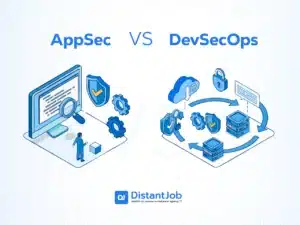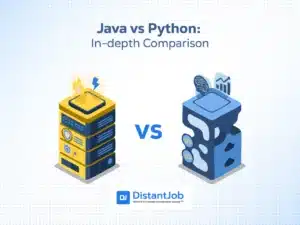The IT field is constantly changing, with databases evolving, new programming languages being scripted, and innovative frameworks. Contrary to what some might think, PHP and Kotlin no longer hold a dominant position in this dynamic environment.
To cut through the clutter, we’ve analyzed the latest trends and compiled a list of the top 9 programming languages for 2024. Here is an overview of different rankings to help you decide which language best fits your project’s needs.
How Many Programming Languages Are There And What To Choose For Your Team
Instead of looking for the best language, a better strategy is to analyze the most used language and its uses. According to the TIOBE Index, there are over 265 programming languages out there. There is a reason why there are so many languages. To put it simply, each language can give you different results depending on the scale and type of project. Usually, programmers learn a dozen of these languages to specialize in a few of them based on their work requirements.
There is no point in looking for someone who can master all of these programming languages. A more strategic method is to isolate the specific needs of your project for each stage of the development process. So, before looking for the winner, let’s have a look at which is the best language to consider in the different phases of the development process:
| Application Area | Programming Languages |
|---|---|
| Front-end Web Development | JavaScript, Elm, TypeScript |
| Back-end Web Development | JavaScript, Scala, Python, Go, Ruby |
| Mobile Application | Swift, Java, Objective C, JavaScript |
| Game Development | Unity, TypeScript |
| Desktop Application | Scala, Go, Python |
| System Programming | Go, Rust |
Based on your needs, you can focus your research on the type of programming language that will give you the best outcome. Here is a comparison between three rankings of the most in-demand programming languages.
Top Programming Languages: Rankings In Comparison
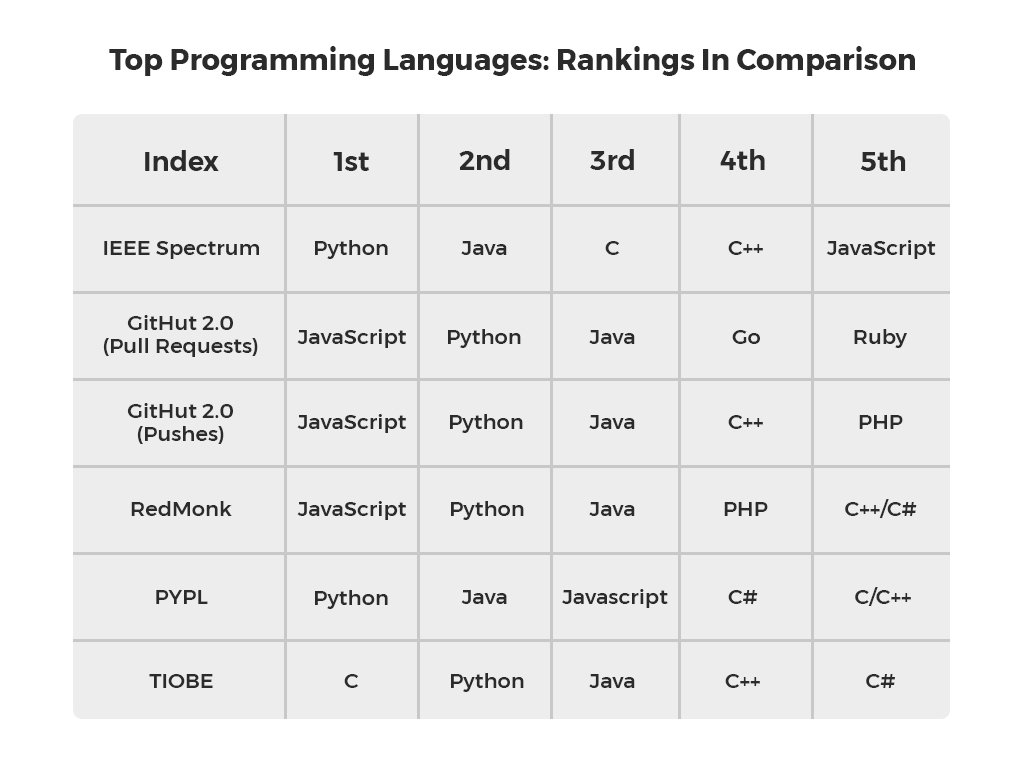
As we mentioned, coding practices evolve like any software or digital device. Some of them were popular in the past and now are forgotten. Some others are immortal, and new ones are taking over. Each year, different rankings come up. And the ‘best language’ can be different depending on which technologies or geographical areas are taken into account.
For example, Ruby is more popular in Japan and South America than anywhere else. Likewise, Python is equally popular worldwide, and C++ is the favorite in India, Pakistan, and Malaysia. When it comes to hiring remotely, it is also crucial to consider where to hire, not only which language is the most used.
Here is a comparison between three different indexes to analyze the most used programming languages:
TIOBE Index
Since 2001, the TIOBE index has been an indicator of the popularity of programming languages, and it’s updated each month. In this index, ratings are the results of twenty-five popular search engines, courses, and third-party vendors—Google, Bing, Yahoo!, Wikipedia, Amazon, YouTube, and Baidu lead the way.
According to 2021’s results, the number one programming language is C. So far, only C and Java hold the podium. However, Python has never been so close to hitting the first position – the bridge between these two is only 0.16%. In fact, C ratings recorded a decline from 20.24% in June 2001 to 11.83% in September 2021. Java is still in the third position on the podium. But it declined from 26.49% in June 2001 to 10.12% in September 202. In addition, Ruby is also getting more popular, moving from position 15 to 13. Finally, Go gained 4 positions, going up from 18 to 14.
On the other hand, PHP has the worst performance. This language was number 3 in 2001 and is now number 17.
To conclude, the TIOBE index is a useful source because it analyzes the most used programming languages – rather than the best ones. If you need to make a strategic decision for a new project, this index is a starting point for an overview of programming languages’ demand and evolution.
Here is the complete list of programming languages based on TIOBE ratings:
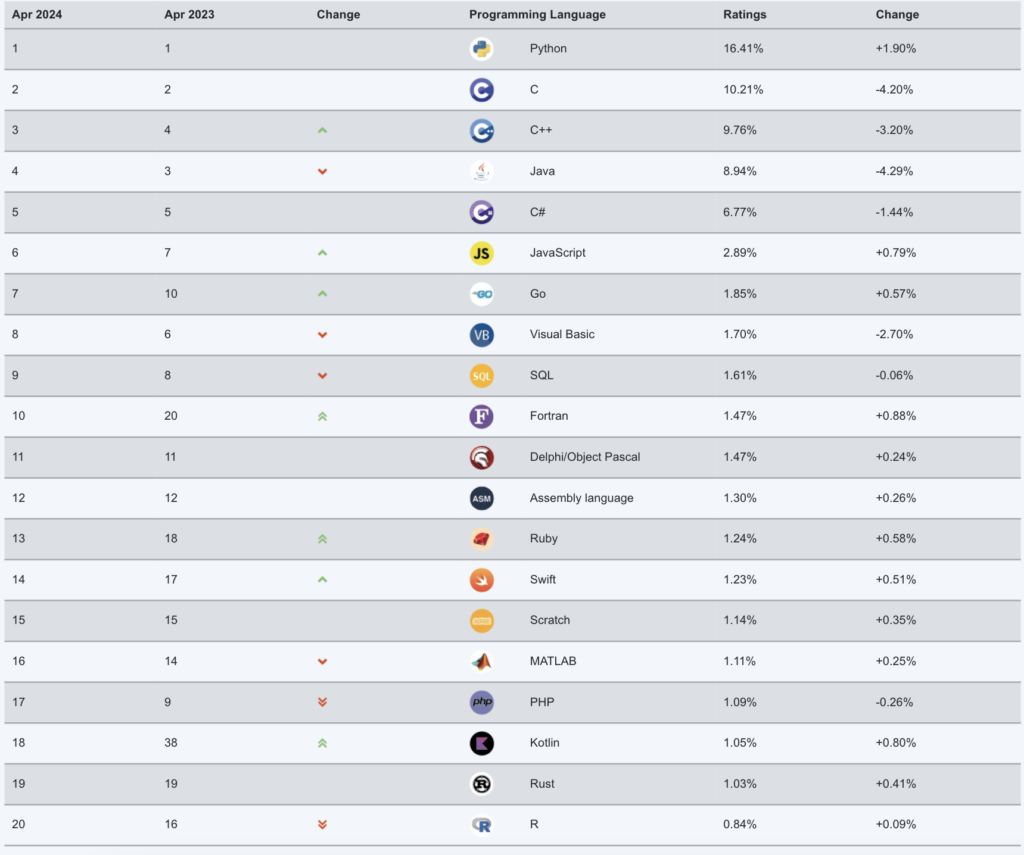
Source: TIOBE Index
PYPL Index Ranking
The Github PYPL Index also analyzes the popularity of programming languages. Their method takes into account which tutorials developers are searching on Google. This index is also updated each month.
In addition to its worldwide index, PYPL publishes separate rankings for the US, India, Germany, the United Kingdom, and France. According to this index, Python is in position number 1 worldwide, followed by Java. To specify, Python has almost doubled its shares (44%) in Germany, the United Kingdom, and France. It has the highest share in France (46%) and the lowest in India (31%).
PYPL also recorded a decline for PHP and Java. From 20% shares in 2008, PHP reached 4.45% in 2024. For Java, the decline is slower but consistent: from 18% in 2021, it dropped to 16%. Both languages are losing popularity, considering that their shares hit 50% in 2004-2009.
Here is the complete list of shares for the ranking:
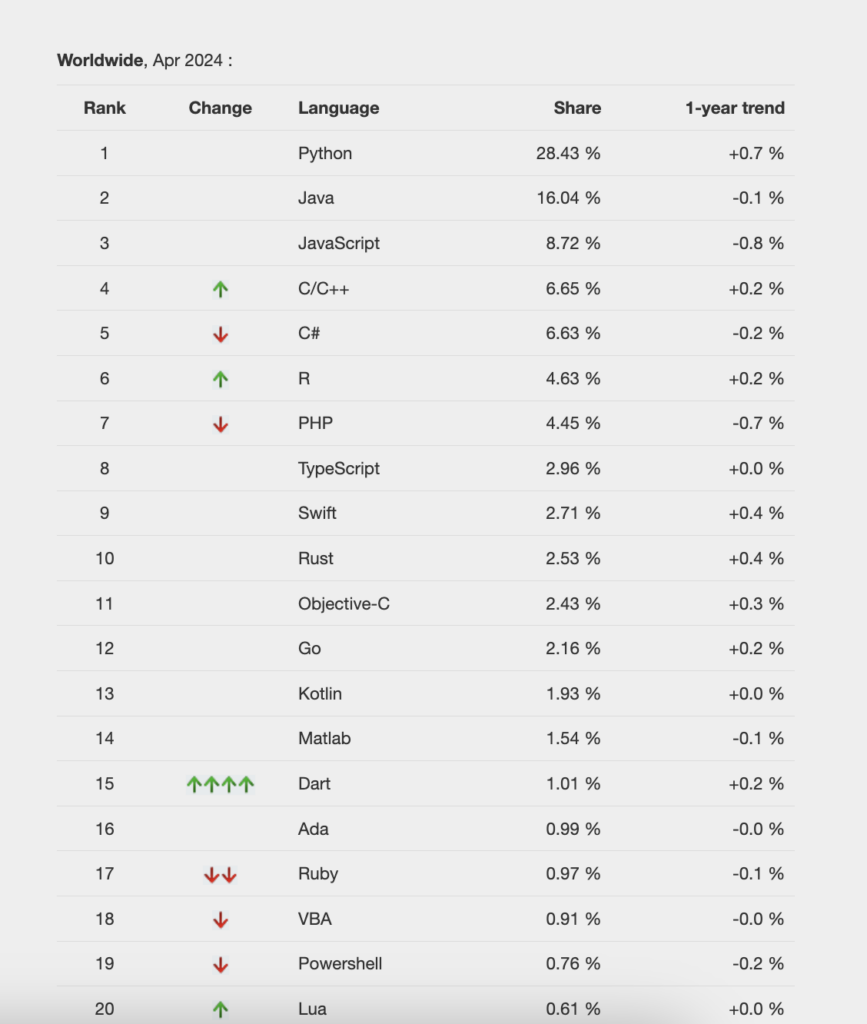
Source: Github PYPL Index
RedMonk’s Q1 2021
For its ratings, RedMonk combines GitHub data and discussions on the developer info-sharing site Stack Overflow. Based on their research, Javascript is number 1, followed by Python and Java. Unlike the first two indexes, PHP maintains a good position (number 4), and C is down the list (number 10). However, their method produces several ties. The results of their analysis determined the following programming languages list:
- JavaScript
- Python
- Java
- PHP
- C#
- C++
- CSS
- TypeScript
- Ruby
- C
- Swift
- R
- Objective-C
- Shell
- Scala
- Go
- PowerShell
- Kotlin
- Rust
- Perl
Here is a complete overview of the first quarter plot for 2021:

Source: RedMonk’s Q1 2021
Top 9 Programming Languages
Based on these indexes, here is our list of the most trending programming languages and their uses:
- Python
- Java
- JavaScript
- C#
- C/C++
- SQL
- Swift
- Go
- Visual Basic
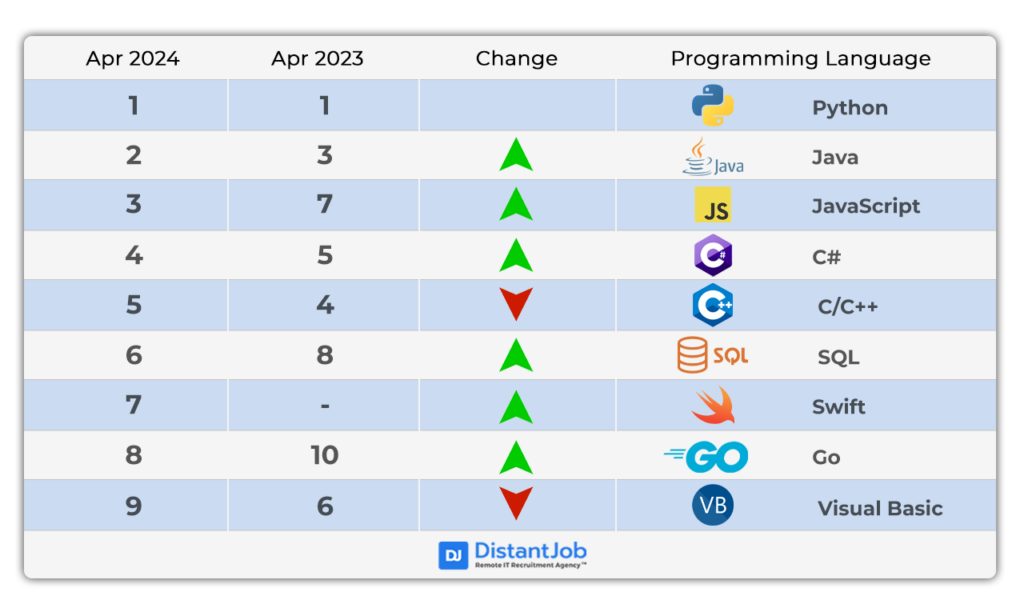
1. Python
Python is a general-purpose coding language for several programming styles, such as functional, object-oriented, and reflective. With this language, you can build multiple digital tools and platforms. For example, YouTube, Google Search, and iRobot machines use it. In addition, for hiring managers, Python is the second-most in-demand programming language after JavaScript.
The language is used for:
- Back end development
- Data Science
- App development
Apps using Python: YouTube, Quora, Reddit, Instagram, Spotify.
2. Java
Java is an object-oriented programming language. Developers can create objects encompassing functions and data to structure programs and applications. Currently, Java ranks is the third most in-demand language for hiring managers worldwide. In addition, Stack Overflow lists it among the most used languages in the past two years.
The language is used for:
- E-commerce
- Finance
- App development
Apps using Java: Google Play, TrainAway app, School App, and Matchplayer for Android.

3. JavaScript
With JavaScript, developers can manage the behavior of web pages by creating animated graphics, interactive maps, and more. According to Stack Overflow’s 2020 Developer Survey, JavaScript is the most commonly used language in the world (69.7%) and the most in-demand programming language for US hiring managers.
The language is used for:
- Web development
- Game development
- Mobile apps
- Building web servers
Apps for JavaScript: Yahoo, eBay, Amazon, Wikipedia.
4. C#
Microsoft released C# in 2002. Since then, C sharp has steadily grown in popularity. Approximately one of every five hiring managers plans to hire a C# developer.
The language is used for:
- Game development
- Desktop/web/mobile apps
- VR
Apps using C#: any desktop Windows apps like Uno, Mono, and .NET Core.
5. C/C++
According to PYPL, C++ and C have the same popularity ratings on Google trends, which is why they both belong in this position. Since its creation in 1973, C has been one of the most popular object-oriented languages. You can program systems like Microsoft Windows, Linux, Mac, iOS, Android, and Windows Phone kernels. In addition, it works on popular databases such as Oracle, MySQL, and MS SQL Server.
The language is used for:
- Game development
- Mobile applications
- Video/photo editing apps
Apps using C/C++: Adobe products, Mozilla browser, and Microsoft software.
6. SQL
SQL (Structured Query Language) is a specialized programming language used for managing and manipulating relational databases. Unlike PHP, which is a server-side scripting language for creating dynamic web pages, SQL is used exclusively to interact with database systems. SQL allows you to perform tasks such as retrieving data from a database, inserting records, updating records, and deleting records from a database table. It is essential for any application that requires data storage and retrieval, which makes it a fundamental tool for backend database management in applications across various industries.
The language is primarily used for:
- Data Querying: Extracting information from databases to be used in analysis or displayed to users.
- Database Management: Creating and managing the architecture of databases, such as tables and relationships.
- Data Manipulation: Inserting, updating, and deleting data within database tables
- Data Access Control: Managing permissions for who can access data in databases.
The language is used for:
Given its critical role in data-driven environments, SQL is a staple in systems ranging from simple data management applications to complex analytical software.
7. Swift
The Swift programming language works with iOS applications. Since 2014, it has been a one-stop platform for future Apple product development. Designed by Apple, Swift runs on macOS, tvOS, watchOS, and z/OS, which power IBM Mainframe computers.
The language is used for:
- iOS applications
- Native applications
- UX design
- Front-end development
Apps using Swift: Slack, Facebook, Uber, Khan Academy, LinkedIn, WhatsApp.
8. Go
Go, often referred to as Golang, is a statically typed, compiled programming language designed at Google by Robert Griesemer, Rob Pike, and Ken Thompson. Launched in 2009, Go was developed to simplify the task of building efficient and scalable software, particularly for complex back-end systems like network servers and tools.
The language is used for:
- Concurrent Programming
- Cloud and Network Services
- Command-line Tools
- Web Development
Go’s design emphasizes simplicity and efficiency, which often results in reliable and easy-to-maintain software. Its powerful standard library, straightforward syntax, and focus on modern computing architectures make it a go-to choice for developers working on high-performance applications.
9. Visual Basic
Visual Basic (VB) is a programming language developed by Microsoft. Introduced in the early 1990s, Visual Basic was designed to be an easy-to-use programming environment for building Windows applications, and it gained popularity for allowing developers to quickly draft graphical user interface (GUI) elements by using drag-and-drop tools.
The language is used for:
- Event-Driven Programming
- Integrated Development Environment (IDE)
- Component Object Model (COM) Integration
- Rapid Application Development (RAD)
Visual Basic evolved over the years into newer versions, notably Visual Basic .NET (VB.NET), which is part of the Microsoft .NET framework. VB.NET expanded VB’s capabilities with powerful features, turning it into a fully object-oriented language that supports modern programming practices.
Conclusion
The programming languages list we proposed is a guide to evaluating what you need for your project. For example, Objective-C hasn’t been the first choice for new projects since Swift appeared. So, if you are launching an iOS app from scratch, Swift is the best choice. On the other hand, if you need to implement a running app built with Objective-C, it’s wiser to work with the same language to improve features and interactions. Finally, Java, JavaScript, and Python are always a wise choice because of their popularity.
To recap, remember that looking for the most popular language isn’t enough to build a productive development team. You want talented developers, and to attract them, you have a solid recruitment strategy. If you need advice on that, we are (remotely) here to help! Our IT recruit experts can find you a developer in less than two weeks, helping you find the best remote programmer – not only the right language!



